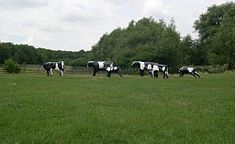Stantonbury
| Stantonbury | |
|---|---|
 Liz Leyh's Concrete Cows |
|
| Stantonbury shown within Buckinghamshire | |
| Population | 10,084 (2011 Census) |
| OS grid reference | SP847414 |
| Civil parish |
|
| Unitary authority | |
| Ceremonial county | |
| Region | |
| Country | England |
| Sovereign state | United Kingdom |
| Post town | MILTON KEYNES |
| Postcode district | MK14 |
| Dialling code | 01908 |
| Police | Thames Valley |
| Fire | Buckinghamshire |
| Ambulance | South Central |
| EU Parliament | South East England |
| UK Parliament | |
Stantonbury is a district of Milton Keynes, Buckinghamshire, England. It is at the northern edge of the city, between Great Linford and Wolverton. It is largely residential, but the greater proportion of the area is taken up by two secondary schools (Stantonbury Campus and the Webber Independent School), a leisure centre with a 25m swimming pool, and an all-weather, competition standard, athletics track.
Modern Stantonbury lies on land (known as "Stanton High", as opposed to "Stanton Low", near the River Great Ouse) of the deserted village of Stantonbury, one of the former Buckinghamshire villages that were included in the area designated in 1967 to become Milton Keynes. The toponym is derived from an Old English term for "fortified building by a farm on stony ground".
The former Church of England parish church of Saint Peter is Norman, with a mid-12th century nave and even earlier chancel. There was a squint in the south wall of the chancel but this was later blocked. St. Peter's was extensively rebuilt in the 13th century and the Decorated Gothic east window and piscina were added in the 14th century. By the latter part of the 17th century Stantonbury was an almost deserted village but the church was still in use, and in 1668–74 the Puritan poet and hymnwriter John Mason was its parish priest. In 1736 only four houses remained in the village but St Peter's was still in use in 1927 and John Piper painted a watercolour of it in about 1940. By 1955 the church had been disused for a number of years and in 1956 the roof collapsed and was not repaired. By 1973 St. Peter's was a ruin, and the east window and ornamented Norman chancel arch had been removed.
...
Wikipedia

